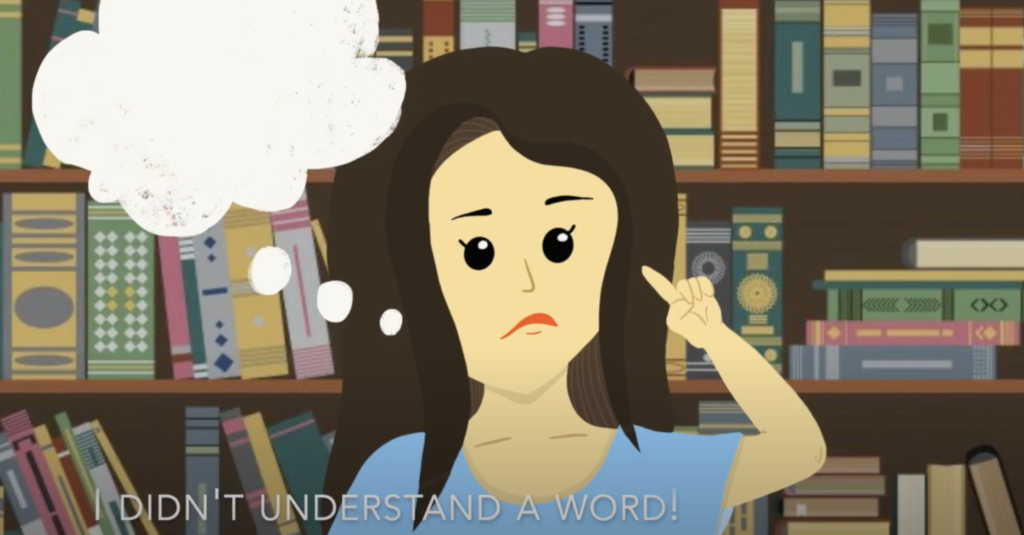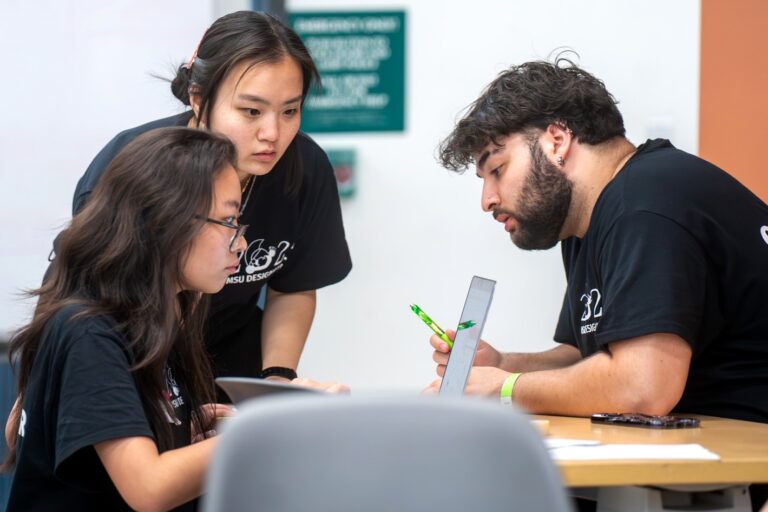
A team of three undergraduate students who came together through WRAC’s First-Year Writing program recently won a Preliminary Research Award for Research in Progress at MSU’s 4th Diversity Research Showcase. The second-year students, Juhua (Hayden) Huang, Panathip (Ky) Chimrak, and Apichaya (Plagrim) Thaneerat, presented on their project “Why Won’t They Talk?”, an exploration of the barriers faced by international students in First-Year Writing classrooms. Mentored by Professors Joyce Meier and Cheryl Caesar and inspired by their own experiences as international students, the Multilingual Learners Video Team worked through challenges of background, time differences, and field expertise to win the award.
The Multilingual Learners Video Team—which includes students Huang, Chimrak, and Thaneerat, and faculty advisors Meier and Caesar—came together in fall 2019 to complete the second phase of an MSU Creating Inclusive Excellence Grant (CIEG) project begun by Meier. The team worked on a video to heighten faculty awareness of the needs of multilingual learners in the classroom and to create a more welcoming, culturally responsive environment for them.
First-year writing as a transformative moment
Although they come from different majors, each of the three students marks their experience with the first-year writing project as a transformative moment in their education. Huang, a mathematics major, first heard about the project during WRA 101: Writing as Inquiry in fall 2019. Chimrak, an Honors College Business-Admitted major, and Thaneerat, a Geographic Information Science major, both from Thailand, were friends before the project and working together was a great opportunity.
“Why Won’t They Talk?” examines the “problem” of international student engagement, but from the student side. International students comprise over 10% of MSU’s student population, and they contribute much to campus life. The aim of such videos is to help make more visible the challenges faced by multilingual learners whose home language is not English, and to encourage professors to adopt practices that frame their international students’ languages and cultures as assets rather than as deficits.
—Dr. Joyce Meier
During the project, the team created their own animated cartoons and voiced the characters themselves (with the exception of the Professor, played by Dr. Matt Rossi, and the American Student, played by Dr. Meier’s son, an MSU alum).
Project impact: Making a difference for international students
The team’s greatest goal is to make a difference for international students. Huang noted that international students often face completely different problems than do domestic students when taking First-Year Writing courses and indeed, university classes more broadly. Students for whom English is not their first language are also becoming accustomed to different vocabulary, grammar, and essay structures than they have learned in their home languages and educational contexts. Chimrak said professors may struggle to teach international students and that the students themselves may be struggling to learn. A critical part of working through this challenge, Chimrak suggests, is learning to see from different perspectives and embracing diverse backgrounds. Chimrak’s advice to first-year writing teachers is to “really listen to them [international students] as they speak slowly or struggle to speak.” Chimrak also indicated that being called on to answer a specific question helped give some students the confidence to speak in class by reassuring them their contributions were important.
As an international student, I need to learn the language, but also I just want someone to see that I’m trying to learn, I’m trying to get better, I’m trying to speak the language… It would feel nice to know another person knows I’m trying to be better.
—Ky Chimrak
Thaneerat voiced a similar opinion, stating that the first time she was called on in class to answer a question, she was “very nervous about speaking and answering,” but when the professor validated her explanation by expanding on it and connecting it to class topics, Thaneerat felt more confident about contributing to the learning community. Thaneerat and Huang both requested that instructors provide the learning materials before class so international students would have adequate time to read, process, and ask questions about the material before each class session. Asked whether the video project might encourage other faculty to embrace similar techniques, Thaneerat replied “I think…when the professors see this video, they will think and recognize ‘that happened to me as well; I know why students are not talking’ and it will inspire them to change.”
Collaboration and video production in a COVID context
Huang, Chimrak, and Thaneerat began their research and the multimedia project in fall 2019, when they could meet with their advisors and each other in physical spaces. But they hit a snag in March 2020, when face-to-face classes and meetings were suspended at MSU, and soon after they returned to their home countries of China and Thailand. The team worked through this transition, meeting online and often at night. The team agreed the most difficult part was coordinating their schedules, noting that not being able to work together face-to-face in the same time zone made it more difficult to communicate.
We almost lost this project in the beginning of the pandemic. I tried to keep in touch with my team at first, but it’s still hard. When the time passed by we got used to how things work…Dr Caesar and Dr. Meier reached out again, continuing with good advice.
—Ky Chimrak
It’s a joy and a spiritual refreshment to work with these students. Despite their geographical separation, they continue to collaborate… Through all the hardships of the last year, they have not lost their drive to share their thoughts and help others, nor their team spirit. They give me hope that we will emerge from the shutdown stronger than ever.
—Cheryl Caesar
Pandemic conditions and a time difference weren’t the only challenges the student team faced. They felt nervous going into the Diversity Research Showcase, especially given that many of the other presenters were further along in their studies and domestic students speaking their home language and working on projects within their majors.
Attending the showcase meant the students had to stay up late into the night to be at the showcase ceremony. Chimrak and Thaneerat both noted the difficulty of staying awake at what was nearly 5:00 in the morning for them. Each of the students noted that their response to hearing they won the award was surprise. Huang stated that it was “exciting definitely; [my] first award in college.” Chimrak, smiling, said “I was so surprised; we did not expect that at all. It was just like having fun, doing this project. We all experienced this as international students, so we just shared our experiences…When I heard my group named, I can’t believe it.” Thaneerat added that “it was amazing to win the award…We did not expect to win.” Although winning a significant, university-wide research award was a high point for the research team, they are also looking forward to what’s ahead: a better teaching and learning experience for international students and their instructors.
That’s a good beginning; everyone knows what we are doing.”
—Apichaya Thaneerat
Huang, Chimrak, and Thaneerat’s “Why Won’t They Talk?” video is currently available for viewing on YouTube. In the near future, this video, along with another made by student Yuyang Cai two years ago, will be hosted on the iteach.msu.edu web site.


